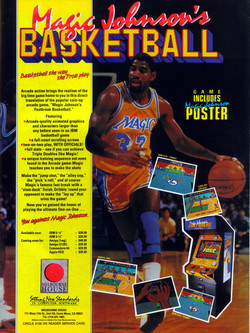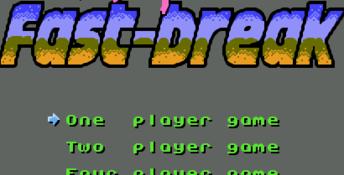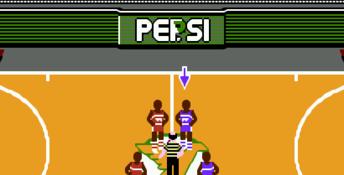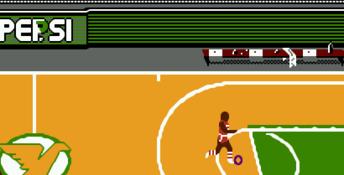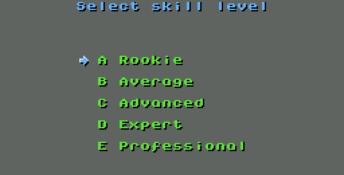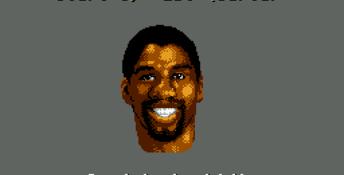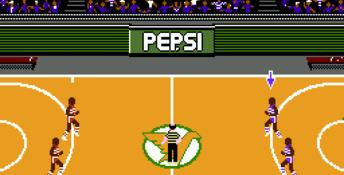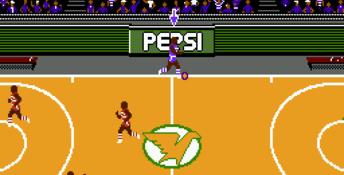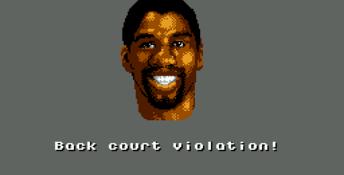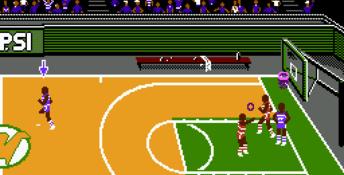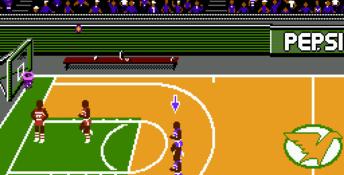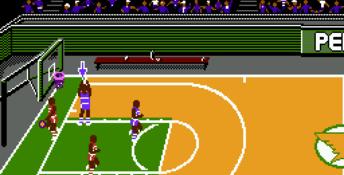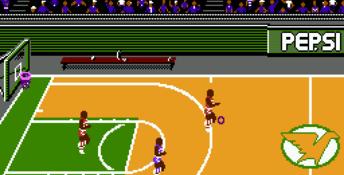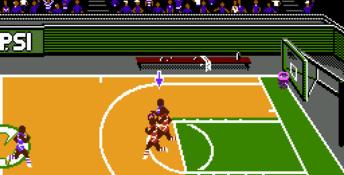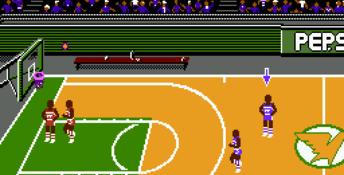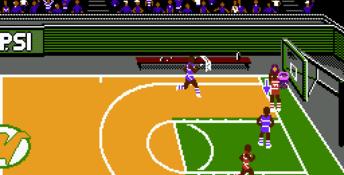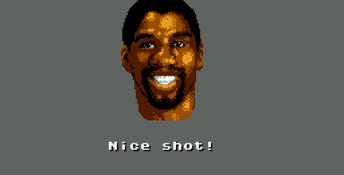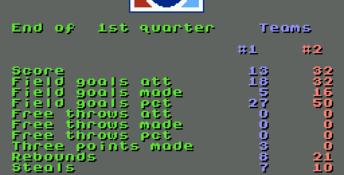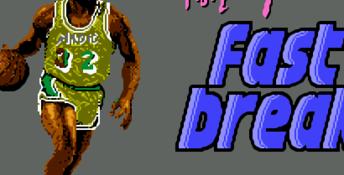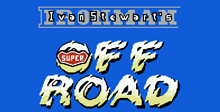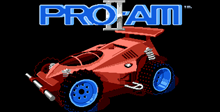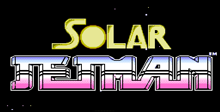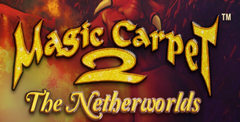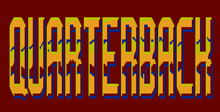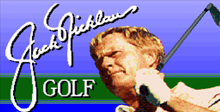Magic Johnson's Fast Break
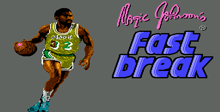
| a game by | Tradewest |
| Genre: | Sports |
| Platform: |
|
| User Rating: | 8.0/10 - 2 votes |
| Rate this game: | |
| See also: | Sport Games, Sports Management Games, Basketball Video Games, NBA Video Games |
- Manufacturer: NES
Machine: Nintendo Entertainment
Sound/Music 6
- Graphics 8
- Playability 8
- Overall 7
The final seconds are ticking off the clock, the shot clock has nearly expired, the roar in the stadium is deafening and your team is down by two points. After a quick cut to the right, back to the left, a pivot outside the three-point line, a jump - with a brief instant of hang time before an effortless, graceful pump - the globe is unleashed in a perfect arc. The buzzer sounds, and the crowd's roar is suddenly silenced as the fans realize that you have pulled off the upset of the century. Swish! A perfect three-point play has unexpectedly shut down Magic Johnson's two-man army. It's just another victory for the armchair NES athlete playing Magic Johnson's Fast Break.
With the assistance of the NES Satellite adapter, up to four players compete in a friendly game of basketball, complete with an NBA referee. One player competes against the NES-controlled opponents while still playing two-on-two. The "B" button toggles selection of the current player controlled by the joystick. The "A" button is used to pass the ball inbounds, shoot for points, jump for rebounds and attempt to steal the ball from the opposing team.
Magic Johnson's Fast Break begins with some nice music and graphic effects, including a stunning likeness of Magic Johnson himself. During game play Magic will appear after a particularly good shot and offer a nice compliment. An impressive effect at first, it tends to interrupt the flow of heated competition after a while.
From the first menu, a one- or two-player game is selected. Unfortunately, two players cannot team up against the computer-controlled team. In the four-player mode, each player controls one man on the court, which makes for some pretty rowdy competition.
In a one-player game, the computer's skill level, from "rookie" to "professional", is selected from the five available. The game is played in four quarters, each three minutes long. Between each quarter a detailed set of statistics is displayed for each team, such as shooting percentage, total free throws, total three-point plays, fouls and more. At the end of a game, the winning team may be awarded a bonus salary. The object is to beat the computer or human opponents, of course, and also to earn as much money as possible. Impressive players can add their initials to a high-score screen, though it's forgotten each time the NES is powered down.
The controls for Magic Johnson's Fast Break are logical and fairly easy to master. Confusing the pass and shoot buttons is almost always costly, however, and takes a bit of getting used to. The action is fast paced, but always fun for multiple players. Contests against the computer are generally a foregone conclusion. Even in the easier levels, "Team Nintendo" almost always wins.
The game does imitate the basic mechanics of basketball. The referee is there, and he'll award foul shots when pertinent. The three-point play can be a real equalizer during the final seconds of a tight game. Scoring shots are not entirely "random", although that element is obviously present. Shot accuracy also seems to be based on the player's timing. Pressing the fire button initiates the jump for the shot, and releasing the button at just the right moment does seem to improve the shooting percentage. The computer's team seems to shoot a pretty solid 50% and seldom tries for a three-point play.
Magic Johnson's Fast Break does have some notable flaws, however. Every player always runs at exactly the same speed, whether he has the ball or not. Logically, you would expect the man dribbling the ball to run a bit more slowly, an element not simulated in this game. So, after a turnover, the player must prepare early and always stay a few steps in front of the opponent. Once a half step behind, a player can not catch up until the opponent pulls up for a shot.
On defense, the fire button is used to attempt a steal or to jump for a rebound. The attempt to jump and block a shot doesn't appear in this simulation, a major flaw. When the opponent is ready to shoot, pressing the fire button still attempts a steal move instead of a "jump to block". A jump response to the fire button seems to occur only when the basketball is rebounding from the rim or backboard.
The players have no personalities of their own. Each player seems to have the same skills, with no variation in play. Other popular basketball simulations simulate a particular player's preference (and increased probability for scoring) for the outside shot or a drive down the lane, for example. This lack of depth makes playing against the computer a pretty uninteresting struggle. Playing against human friends depends on genuine skill more than the computer; although, even here, the player not currently under joystick control is manipulated by the computer. A rousing game of one-on-one, with no second player on each team, would have been a nice play option for this game.
Magic Johnson's Fast Break sports superior graphics, good sound effects and excellent, smooth animation of the players and the basketball. The player movements are fluid and natural looking. The mechanics of game play are simulated nicely, but it does lack some depth. It is best suited as a multi-player game, using the player vs. computer scenario primarily as a rote drill practice for your next big tournament against a friend.
Download Magic Johnson's Fast Break

System requirements:
- PC compatible
- Operating systems: Windows 10/Windows 8/Windows 7/2000/Vista/WinXP
- P-200, 32 MB RAM
Game Reviews
- Manufacturer: Accolade
- Version: Commodore 64
Steve Cartwright, author of Fast Break, presents an action-oriented hoop contest that also considers the strategic aspects of Dr. Naismith's invention.
Although the computerist still directs the three-man team on the court in Fast Break, auxiliary screens let the coach pick the starting lineup from the roster, select preset plays which can be called during the game and even design unique strategies for the team to execute.
These frills are excellent additions, but the core of the game must always be the action on the hardwood. Unfortunately, Fast Break is not a great game when the action moves from the locker room to the court. It lacks foul shooting, the user-interface is cumbersome, and there are annoying bugs in the program.
Fast Break is a one- or two-player game. Participants can choose the Slammers or the Jammers. Each of the teams has two centers, two guards and two forwards, so there is a choice at every position. A coach can examine the players one at a time, weighing each man's strengths and weaknesses. Substitutions can be made during the course of the game, but only during time-outs or between quarters.
The perspective will be familiar to viewers of TV basketball broadcasts. The two-thirds view gives players lots of room to move in all directions. Only one half of the court is shown at a time, the display jumping to the other basket whenever a team crosses the midline with the ball.
The players, depicted in side view, are large and nicely drawn. Too bad it is impossible to tell them apart without reading the play summaries printed in boxes below the court display. The computerist must constantly divide his attention between what the players are doing and the text report, which makes play somewhat tedious.
The control system is extremely simple, but it is too easy to mix up the commands. The player guides the flashing player around the court with the joystick. Pressing the button briefly, when the ball handler is facing in the general direction of a teammate, tosses a quick pass. The other team can try to intercept the throw, by sending a man between the passer and the ball's intended recipient.
The player under joystick control blinks constantly. It makes him stand out from his cohorts, but it looks terrible on the screen. When playing defense, a quick press of the action button switches control to another man on the floor.
Preset plays give Fast Break a richer texture than games in which all the action is spontaneous. Coaches don't have to use them, but they add a pleasing note of realism.
The computerist creates up to four plays prior to the start of a contest. Prompts guide the user through the process of moving each of the players around the front court to set up the pattern. There is also a bank of maneuvers ready for use for those who want a shortcut.
During an actual game, lingering at half court or moving back toward the midline after reaching the key, puts the play section box on the screen.
The coach then holds down the button and points the stick in the direction which corresponds to the desired play.
A player can shoot whenever he has the ball at his end of the court. Pressing and holding the action button causes the hoopster to leap into the air for a jump shot. The computerist releases the button when the marksman reaches the top of his leap to send the ball whooshing through the cords. Teams can take two- or three-point shots, as in the actual sport.
If the offense misses, both sides scramble for the rebound. When the ball comes off the rim, pressing and holding the button may snare the rebound if the controlled player is properly positioned. It is also possible to block a shot by pressing the button to make the defender leap when the shooter goes up with the ball.
Despite the absence of free throws, the referees still call infractions. The officials can cite the ball handler for charging or the defender for hacking. Any man who accumulates six personal fouls gets an early shower.
If the offense uses up the 24-second clock or fails to get the ball past mid-court in ten seconds, it is a violation. It results in loss of the ball, but no personal foul.
The program freezes after almost every basket. The computerist can twiddle the joystick for up to one minute before a player on the screen moves to pick up the ball to start the next play.
But there's a lot to like about Fast Break. It contains some nice ideas, and its design embodies a subtle understanding of the sport's nuances. All the good work is sabotaged, however, by the previously mentioned defects. Perhaps the game's eventual move to higher-memory computer systems will yield editions which retain the positive aspects while shedding the negative ones.
What looks like basketball, plays like basketball, and even sounds like basketball, but isn't exactly basketball? Nawww, it isn't the L.A. Clippers or the Charlotte Hornets. Try Magic Johnson's Fast Break from Tradewest.
Two-on-Two
Now, don't lose your cool, Lakers fans. You can bet a new pair of Air Jordans that any NES B-ball game with the Magic Man's name on it is going to provide some monster hoops. But basketball purists should note that Fast Break offers fast-paced two-on-two basketball action rather than the usual five-on-five contest.
On screen you get full-court, horizontally scrolling action. There's a 24-second shot clock; a scoreboard, and a Team Foul counter. A referee monitors the action and a fanatical crowd cheers you on.
You control one player at a time. An arrow appears onscreen above the head of the player you're running. Just hit B to switch players. You can play against the computer or a friend. With an NES Satellite, four people can play at once.
ProTip: Team defense creates turnovers. Learn to double team the ball handler by pressing B quickly to always keep a player in his face.
Your team starts each game at a certain salary level. Your goal is to beat the pants off the opposition to earn a salary. Keep winning and you might etch your name onto the Big Earners screen.
Technical Fouls
Hoops freaks will quickly notice Fast Break's soft spots. First off, all the players have the same moves and the same skill levels.
Shooting's really hit or miss. You can pull up for jumpers, take a three pointer, or drive to the basket, but you can't put any touch on your shots. The closer you are to the hoop, the more likely your shot will drop. And although you can dunk after a fashion, you can't perform spectacular slams. Most shots inside the paint resemble the old two-hand set shot.
Finally, you can steal the ball and grab rebounds, but you can't block shots. On the whole, for a game that bases its draw on one of the most creative players in the NBA. Fast Break is a tad limited in the degree of creativity it allows you on court. So much for the basketball-junkie gripes.
Takin' It to the Hoop
What Fast Break trades off in sweaty details it makes up for with non-stop action. You don't have to spend a lot of time setting up the game, selecting teams, or substituting players; you just suck in a deep breath and go to it.
If you dribble the ball up court, hug the near sideline. It's almost impossible for the defender to make a steal, and you never step out of bounds.
When they labeled this game "Fast Break," they weren't kidding around! Since there are only four players onscreen, there's plenty of room for no-holds-barred, run and gun hoops. You even hear the fans roar and the basket-ball shoes squeal as players zip up and down the court. And both teams can really rack up the points for radical scoring!
The draw and kick is a good offensive play. Drive to the hoop, draw the defenders to you, and then kick the ball out to your open man for an uncontested shot.
The computer, in particular, is no slouch. It'll burn you if you don't get back on defense and pop a three-pointer when you jam up the middle.
- Computer opponents are fast, so don't try to make a pass when they're near your passing lane or they'll intercept it.
- After they score, the computer players are a might slow getting back on D. When you inbound the hall, send a player down court off screen. Then press B to pass. (The longer you wait, the closer he gets to the basket, but watch out for a five second violation.) It's an easy two, if you don't blow the shot.
Making A Game of It
You get five skill levels from Rookie to Professional. Each level provides quicker game-play, tougher defense, and bigger bucks if you win. A game lasts four three-minute, real-time quarters. In between quarters, you can review stats such as field goal percentage, three-pointers made, rebounds, and steals. If the score is tied at the final buzzer, you play additional quarters until someone wins. As you play, an excellent image of the Magic Man pops up to congratulate you for a good shot and offer a few words of basketball wisdom.
Foul Play
The referee isn't there just for looks. He'll call fouls (including offensive fouls) if the game-play gets too rough. Five team fouls nets two free throws. The ref also whistles back-court violations. He'll even call five-second violations for taking too long to inbound the ball and ten-second violations for not making it across midcourt in time.
At the Buzzer
Magic Johnson's Fast Break is a fast-paced, addicting game of video Two-On-Two. The game-play is simple to learn, and it really grabs you. Playing the computer is a kick and multi-player games are a blast! So, lace up your sneakers and loosen up your fingers; Fast Break ain't Showtime, but it's got Magic.
